In-depth Report on Mount Pinatubo Volcanic Mountain Eruption
VerifiedAdded on 2023/05/31
|7
|1372
|196
Report
AI Summary
This report provides a comprehensive analysis of Mount Pinatubo, a stratovolcano located on Luzon Island in the Philippines. It discusses the volcano's location at the boundary between the Philippine and Eurasian plates, its age, and its classification as a stratovolcano with a dome complex shape. The report details the two distinct phases of Pinatubo's formation, the rock types (dacite and andesitic xenoliths), and key physical features such as volcanic plugs, vents, and lahars. A significant portion of the report focuses on the eruption history, particularly the catastrophic event of June 1991, including its causes and impacts, such as loss of life, economic damage, and disruption of the central Luzon economy. Finally, the report touches on future expectations, noting the potential for future eruptions based on historical patterns, and suggests that the next major eruption could occur approximately 500 years from now. Desklib provides students access to similar solved assignments and resources.
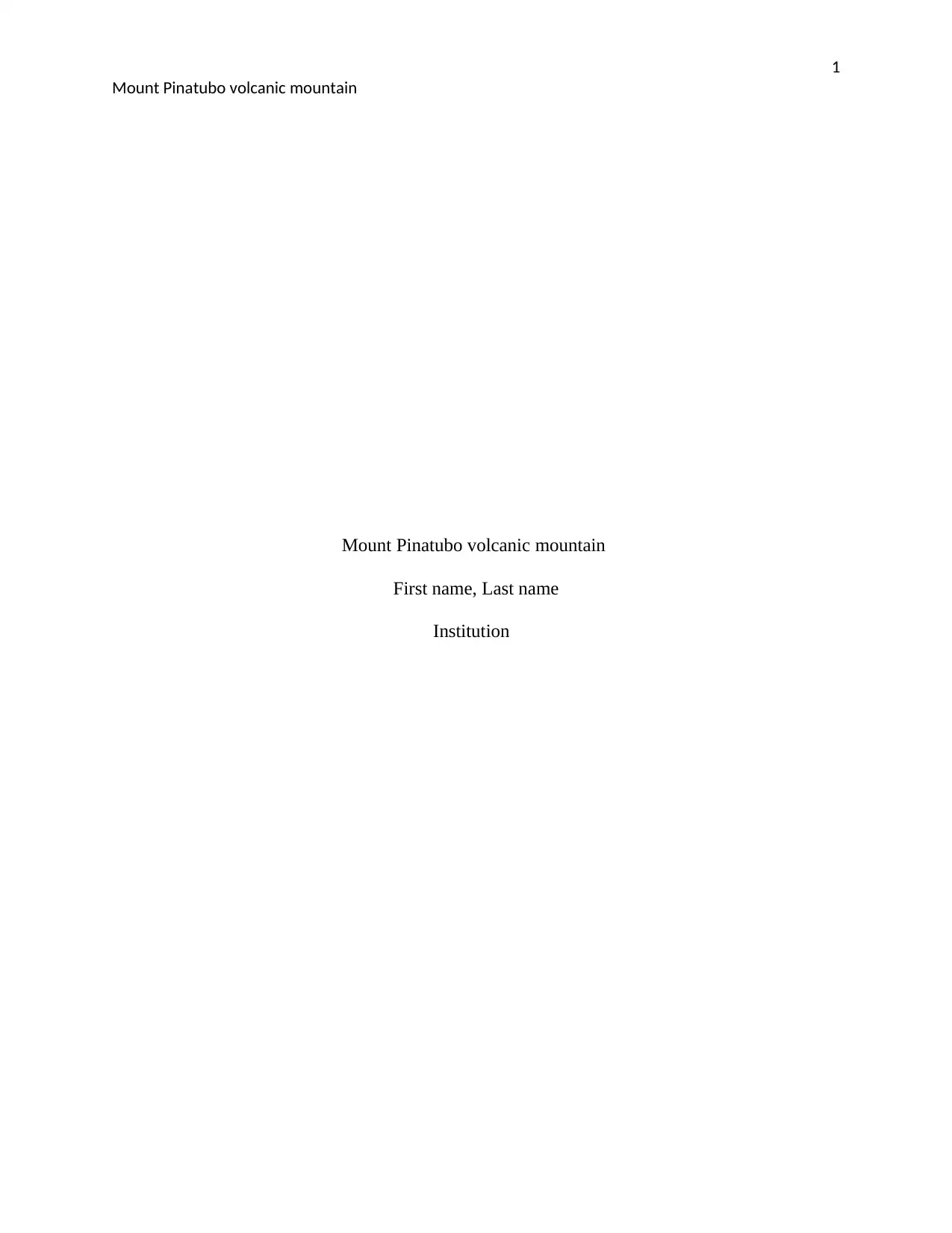
1
Mount Pinatubo volcanic mountain
Mount Pinatubo volcanic mountain
First name, Last name
Institution
Mount Pinatubo volcanic mountain
Mount Pinatubo volcanic mountain
First name, Last name
Institution
Paraphrase This Document
Need a fresh take? Get an instant paraphrase of this document with our AI Paraphraser
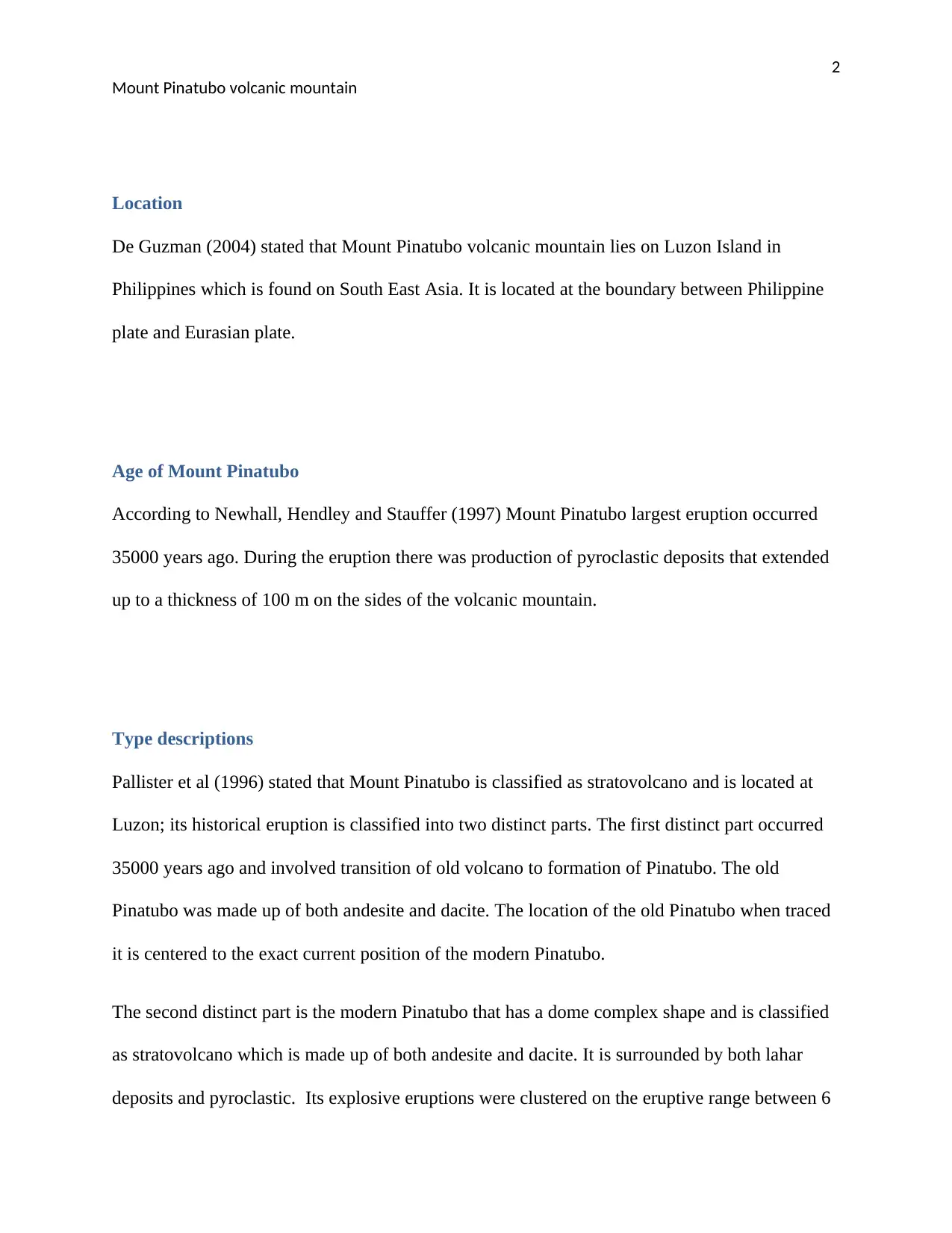
2
Mount Pinatubo volcanic mountain
Location
De Guzman (2004) stated that Mount Pinatubo volcanic mountain lies on Luzon Island in
Philippines which is found on South East Asia. It is located at the boundary between Philippine
plate and Eurasian plate.
Age of Mount Pinatubo
According to Newhall, Hendley and Stauffer (1997) Mount Pinatubo largest eruption occurred
35000 years ago. During the eruption there was production of pyroclastic deposits that extended
up to a thickness of 100 m on the sides of the volcanic mountain.
Type descriptions
Pallister et al (1996) stated that Mount Pinatubo is classified as stratovolcano and is located at
Luzon; its historical eruption is classified into two distinct parts. The first distinct part occurred
35000 years ago and involved transition of old volcano to formation of Pinatubo. The old
Pinatubo was made up of both andesite and dacite. The location of the old Pinatubo when traced
it is centered to the exact current position of the modern Pinatubo.
The second distinct part is the modern Pinatubo that has a dome complex shape and is classified
as stratovolcano which is made up of both andesite and dacite. It is surrounded by both lahar
deposits and pyroclastic. Its explosive eruptions were clustered on the eruptive range between 6
Mount Pinatubo volcanic mountain
Location
De Guzman (2004) stated that Mount Pinatubo volcanic mountain lies on Luzon Island in
Philippines which is found on South East Asia. It is located at the boundary between Philippine
plate and Eurasian plate.
Age of Mount Pinatubo
According to Newhall, Hendley and Stauffer (1997) Mount Pinatubo largest eruption occurred
35000 years ago. During the eruption there was production of pyroclastic deposits that extended
up to a thickness of 100 m on the sides of the volcanic mountain.
Type descriptions
Pallister et al (1996) stated that Mount Pinatubo is classified as stratovolcano and is located at
Luzon; its historical eruption is classified into two distinct parts. The first distinct part occurred
35000 years ago and involved transition of old volcano to formation of Pinatubo. The old
Pinatubo was made up of both andesite and dacite. The location of the old Pinatubo when traced
it is centered to the exact current position of the modern Pinatubo.
The second distinct part is the modern Pinatubo that has a dome complex shape and is classified
as stratovolcano which is made up of both andesite and dacite. It is surrounded by both lahar
deposits and pyroclastic. Its explosive eruptions were clustered on the eruptive range between 6
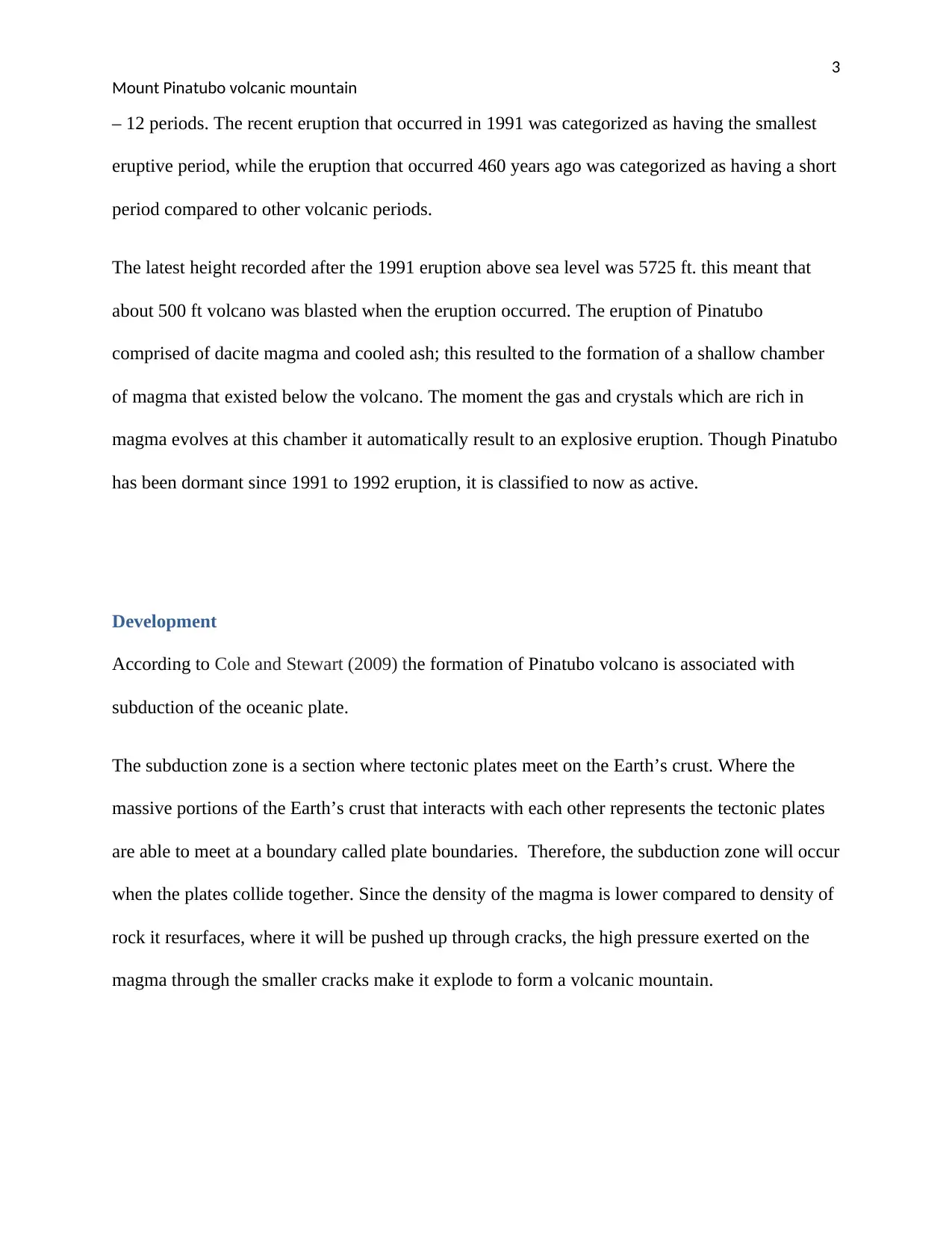
3
Mount Pinatubo volcanic mountain
– 12 periods. The recent eruption that occurred in 1991 was categorized as having the smallest
eruptive period, while the eruption that occurred 460 years ago was categorized as having a short
period compared to other volcanic periods.
The latest height recorded after the 1991 eruption above sea level was 5725 ft. this meant that
about 500 ft volcano was blasted when the eruption occurred. The eruption of Pinatubo
comprised of dacite magma and cooled ash; this resulted to the formation of a shallow chamber
of magma that existed below the volcano. The moment the gas and crystals which are rich in
magma evolves at this chamber it automatically result to an explosive eruption. Though Pinatubo
has been dormant since 1991 to 1992 eruption, it is classified to now as active.
Development
According to Cole and Stewart (2009) the formation of Pinatubo volcano is associated with
subduction of the oceanic plate.
The subduction zone is a section where tectonic plates meet on the Earth’s crust. Where the
massive portions of the Earth’s crust that interacts with each other represents the tectonic plates
are able to meet at a boundary called plate boundaries. Therefore, the subduction zone will occur
when the plates collide together. Since the density of the magma is lower compared to density of
rock it resurfaces, where it will be pushed up through cracks, the high pressure exerted on the
magma through the smaller cracks make it explode to form a volcanic mountain.
Mount Pinatubo volcanic mountain
– 12 periods. The recent eruption that occurred in 1991 was categorized as having the smallest
eruptive period, while the eruption that occurred 460 years ago was categorized as having a short
period compared to other volcanic periods.
The latest height recorded after the 1991 eruption above sea level was 5725 ft. this meant that
about 500 ft volcano was blasted when the eruption occurred. The eruption of Pinatubo
comprised of dacite magma and cooled ash; this resulted to the formation of a shallow chamber
of magma that existed below the volcano. The moment the gas and crystals which are rich in
magma evolves at this chamber it automatically result to an explosive eruption. Though Pinatubo
has been dormant since 1991 to 1992 eruption, it is classified to now as active.
Development
According to Cole and Stewart (2009) the formation of Pinatubo volcano is associated with
subduction of the oceanic plate.
The subduction zone is a section where tectonic plates meet on the Earth’s crust. Where the
massive portions of the Earth’s crust that interacts with each other represents the tectonic plates
are able to meet at a boundary called plate boundaries. Therefore, the subduction zone will occur
when the plates collide together. Since the density of the magma is lower compared to density of
rock it resurfaces, where it will be pushed up through cracks, the high pressure exerted on the
magma through the smaller cracks make it explode to form a volcanic mountain.
⊘ This is a preview!⊘
Do you want full access?
Subscribe today to unlock all pages.

Trusted by 1+ million students worldwide
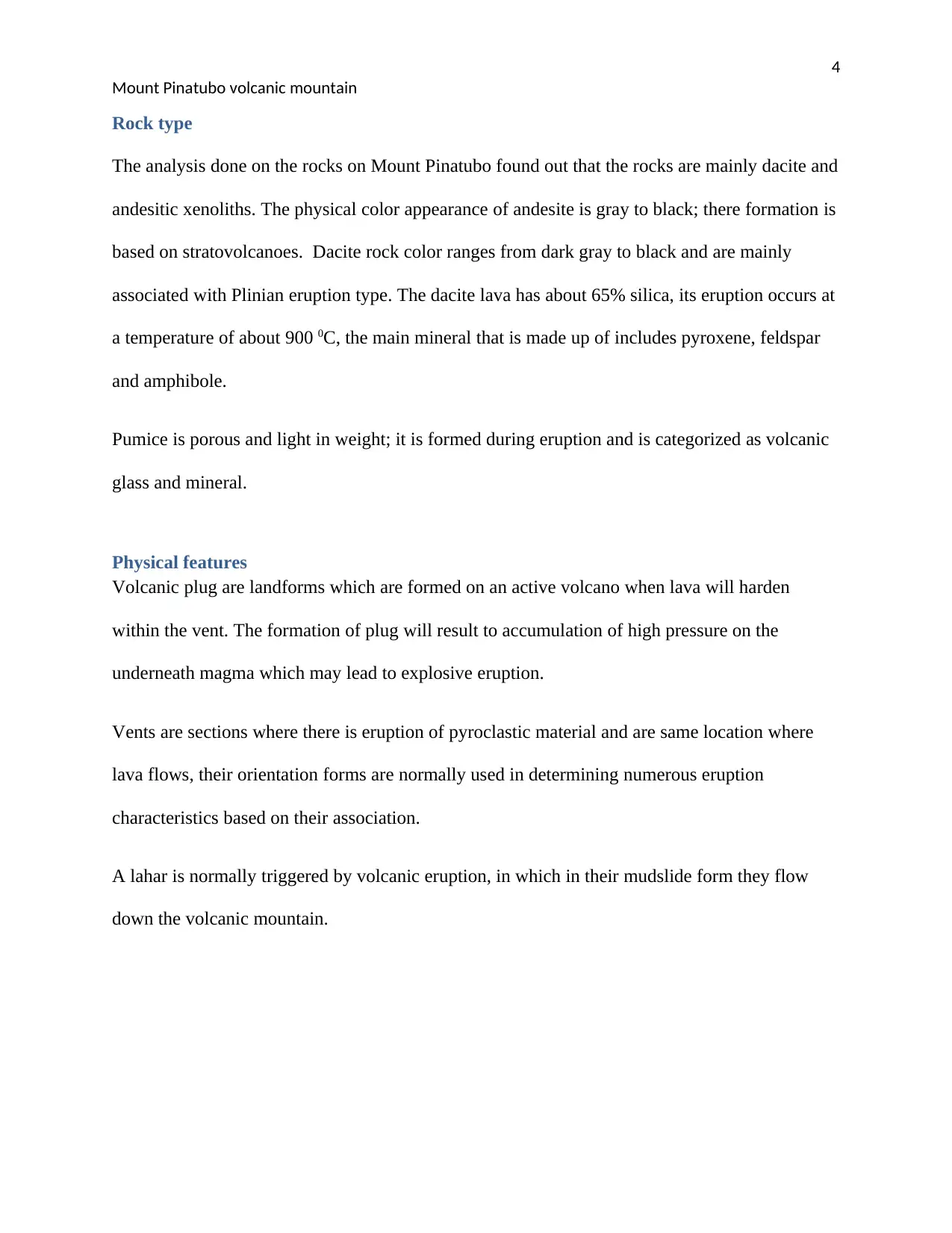
4
Mount Pinatubo volcanic mountain
Rock type
The analysis done on the rocks on Mount Pinatubo found out that the rocks are mainly dacite and
andesitic xenoliths. The physical color appearance of andesite is gray to black; there formation is
based on stratovolcanoes. Dacite rock color ranges from dark gray to black and are mainly
associated with Plinian eruption type. The dacite lava has about 65% silica, its eruption occurs at
a temperature of about 900 0C, the main mineral that is made up of includes pyroxene, feldspar
and amphibole.
Pumice is porous and light in weight; it is formed during eruption and is categorized as volcanic
glass and mineral.
Physical features
Volcanic plug are landforms which are formed on an active volcano when lava will harden
within the vent. The formation of plug will result to accumulation of high pressure on the
underneath magma which may lead to explosive eruption.
Vents are sections where there is eruption of pyroclastic material and are same location where
lava flows, their orientation forms are normally used in determining numerous eruption
characteristics based on their association.
A lahar is normally triggered by volcanic eruption, in which in their mudslide form they flow
down the volcanic mountain.
Mount Pinatubo volcanic mountain
Rock type
The analysis done on the rocks on Mount Pinatubo found out that the rocks are mainly dacite and
andesitic xenoliths. The physical color appearance of andesite is gray to black; there formation is
based on stratovolcanoes. Dacite rock color ranges from dark gray to black and are mainly
associated with Plinian eruption type. The dacite lava has about 65% silica, its eruption occurs at
a temperature of about 900 0C, the main mineral that is made up of includes pyroxene, feldspar
and amphibole.
Pumice is porous and light in weight; it is formed during eruption and is categorized as volcanic
glass and mineral.
Physical features
Volcanic plug are landforms which are formed on an active volcano when lava will harden
within the vent. The formation of plug will result to accumulation of high pressure on the
underneath magma which may lead to explosive eruption.
Vents are sections where there is eruption of pyroclastic material and are same location where
lava flows, their orientation forms are normally used in determining numerous eruption
characteristics based on their association.
A lahar is normally triggered by volcanic eruption, in which in their mudslide form they flow
down the volcanic mountain.
Paraphrase This Document
Need a fresh take? Get an instant paraphrase of this document with our AI Paraphraser
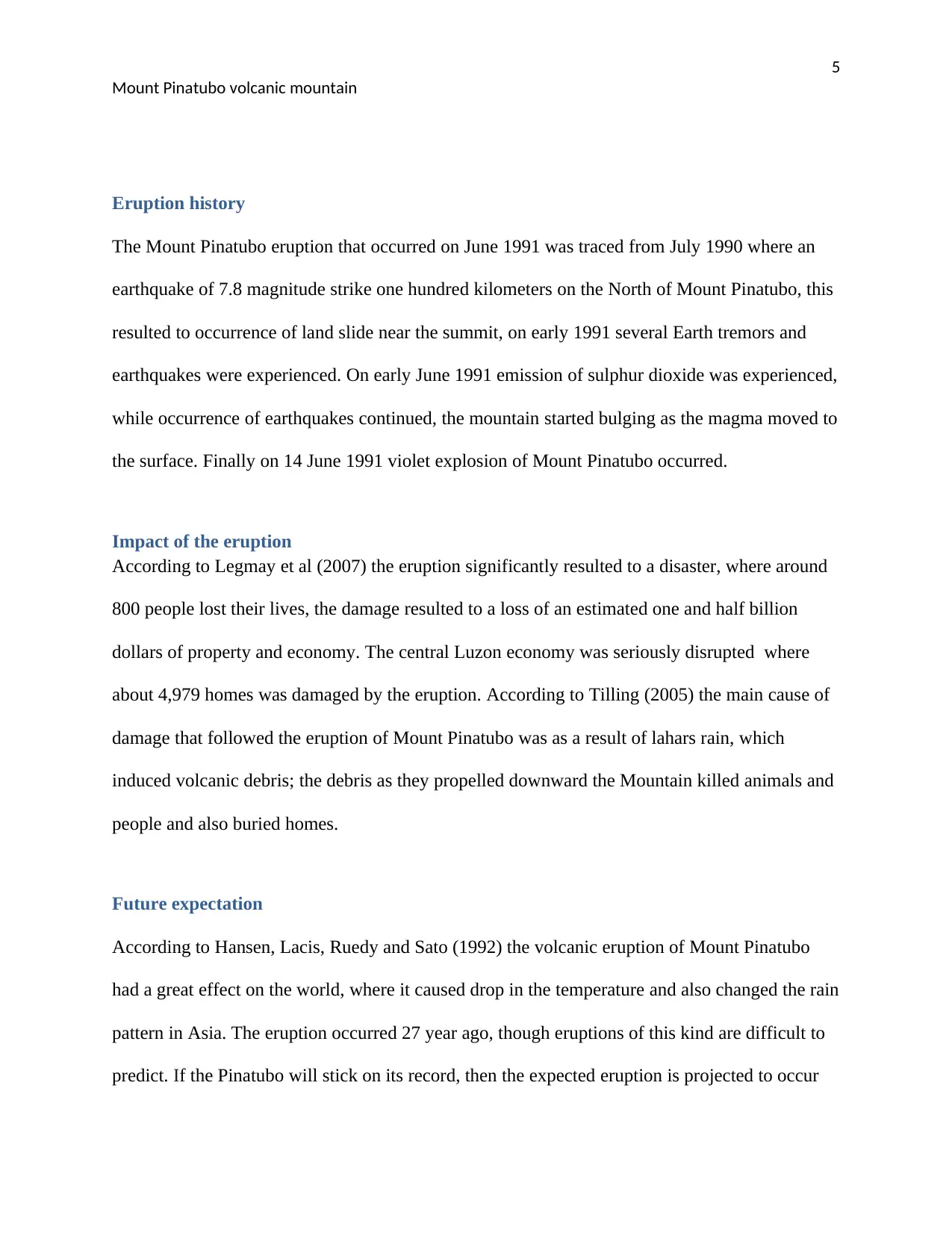
5
Mount Pinatubo volcanic mountain
Eruption history
The Mount Pinatubo eruption that occurred on June 1991 was traced from July 1990 where an
earthquake of 7.8 magnitude strike one hundred kilometers on the North of Mount Pinatubo, this
resulted to occurrence of land slide near the summit, on early 1991 several Earth tremors and
earthquakes were experienced. On early June 1991 emission of sulphur dioxide was experienced,
while occurrence of earthquakes continued, the mountain started bulging as the magma moved to
the surface. Finally on 14 June 1991 violet explosion of Mount Pinatubo occurred.
Impact of the eruption
According to Legmay et al (2007) the eruption significantly resulted to a disaster, where around
800 people lost their lives, the damage resulted to a loss of an estimated one and half billion
dollars of property and economy. The central Luzon economy was seriously disrupted where
about 4,979 homes was damaged by the eruption. According to Tilling (2005) the main cause of
damage that followed the eruption of Mount Pinatubo was as a result of lahars rain, which
induced volcanic debris; the debris as they propelled downward the Mountain killed animals and
people and also buried homes.
Future expectation
According to Hansen, Lacis, Ruedy and Sato (1992) the volcanic eruption of Mount Pinatubo
had a great effect on the world, where it caused drop in the temperature and also changed the rain
pattern in Asia. The eruption occurred 27 year ago, though eruptions of this kind are difficult to
predict. If the Pinatubo will stick on its record, then the expected eruption is projected to occur
Mount Pinatubo volcanic mountain
Eruption history
The Mount Pinatubo eruption that occurred on June 1991 was traced from July 1990 where an
earthquake of 7.8 magnitude strike one hundred kilometers on the North of Mount Pinatubo, this
resulted to occurrence of land slide near the summit, on early 1991 several Earth tremors and
earthquakes were experienced. On early June 1991 emission of sulphur dioxide was experienced,
while occurrence of earthquakes continued, the mountain started bulging as the magma moved to
the surface. Finally on 14 June 1991 violet explosion of Mount Pinatubo occurred.
Impact of the eruption
According to Legmay et al (2007) the eruption significantly resulted to a disaster, where around
800 people lost their lives, the damage resulted to a loss of an estimated one and half billion
dollars of property and economy. The central Luzon economy was seriously disrupted where
about 4,979 homes was damaged by the eruption. According to Tilling (2005) the main cause of
damage that followed the eruption of Mount Pinatubo was as a result of lahars rain, which
induced volcanic debris; the debris as they propelled downward the Mountain killed animals and
people and also buried homes.
Future expectation
According to Hansen, Lacis, Ruedy and Sato (1992) the volcanic eruption of Mount Pinatubo
had a great effect on the world, where it caused drop in the temperature and also changed the rain
pattern in Asia. The eruption occurred 27 year ago, though eruptions of this kind are difficult to
predict. If the Pinatubo will stick on its record, then the expected eruption is projected to occur

6
Mount Pinatubo volcanic mountain
500 years to come, since prior history suggested that it took about 500 years for the eruption of
1991 to occur.
Mount Pinatubo volcanic mountain
500 years to come, since prior history suggested that it took about 500 years for the eruption of
1991 to occur.
⊘ This is a preview!⊘
Do you want full access?
Subscribe today to unlock all pages.

Trusted by 1+ million students worldwide
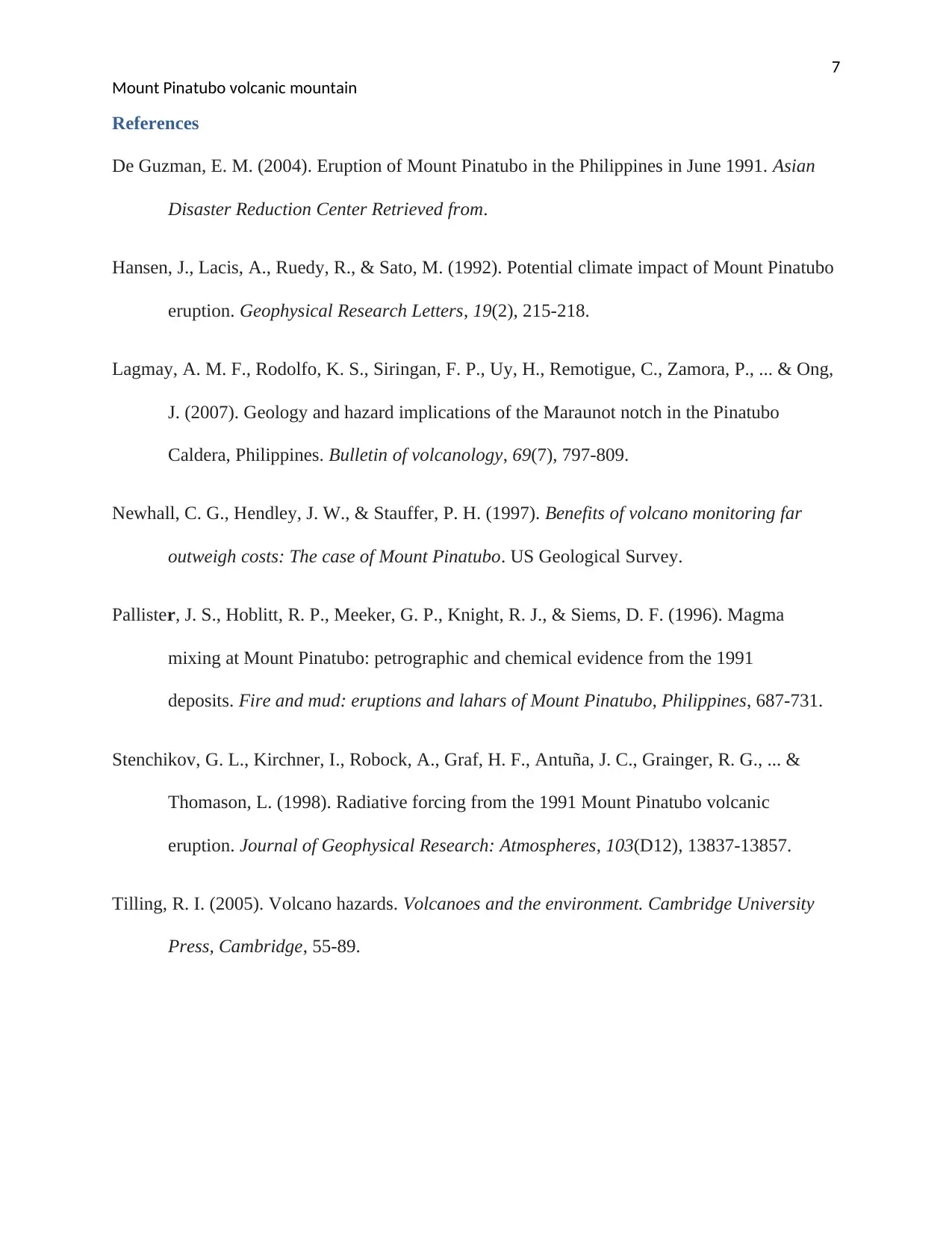
7
Mount Pinatubo volcanic mountain
References
De Guzman, E. M. (2004). Eruption of Mount Pinatubo in the Philippines in June 1991. Asian
Disaster Reduction Center Retrieved from.
Hansen, J., Lacis, A., Ruedy, R., & Sato, M. (1992). Potential climate impact of Mount Pinatubo
eruption. Geophysical Research Letters, 19(2), 215-218.
Lagmay, A. M. F., Rodolfo, K. S., Siringan, F. P., Uy, H., Remotigue, C., Zamora, P., ... & Ong,
J. (2007). Geology and hazard implications of the Maraunot notch in the Pinatubo
Caldera, Philippines. Bulletin of volcanology, 69(7), 797-809.
Newhall, C. G., Hendley, J. W., & Stauffer, P. H. (1997). Benefits of volcano monitoring far
outweigh costs: The case of Mount Pinatubo. US Geological Survey.
Pallister, J. S., Hoblitt, R. P., Meeker, G. P., Knight, R. J., & Siems, D. F. (1996). Magma
mixing at Mount Pinatubo: petrographic and chemical evidence from the 1991
deposits. Fire and mud: eruptions and lahars of Mount Pinatubo, Philippines, 687-731.
Stenchikov, G. L., Kirchner, I., Robock, A., Graf, H. F., Antuña, J. C., Grainger, R. G., ... &
Thomason, L. (1998). Radiative forcing from the 1991 Mount Pinatubo volcanic
eruption. Journal of Geophysical Research: Atmospheres, 103(D12), 13837-13857.
Tilling, R. I. (2005). Volcano hazards. Volcanoes and the environment. Cambridge University
Press, Cambridge, 55-89.
Mount Pinatubo volcanic mountain
References
De Guzman, E. M. (2004). Eruption of Mount Pinatubo in the Philippines in June 1991. Asian
Disaster Reduction Center Retrieved from.
Hansen, J., Lacis, A., Ruedy, R., & Sato, M. (1992). Potential climate impact of Mount Pinatubo
eruption. Geophysical Research Letters, 19(2), 215-218.
Lagmay, A. M. F., Rodolfo, K. S., Siringan, F. P., Uy, H., Remotigue, C., Zamora, P., ... & Ong,
J. (2007). Geology and hazard implications of the Maraunot notch in the Pinatubo
Caldera, Philippines. Bulletin of volcanology, 69(7), 797-809.
Newhall, C. G., Hendley, J. W., & Stauffer, P. H. (1997). Benefits of volcano monitoring far
outweigh costs: The case of Mount Pinatubo. US Geological Survey.
Pallister, J. S., Hoblitt, R. P., Meeker, G. P., Knight, R. J., & Siems, D. F. (1996). Magma
mixing at Mount Pinatubo: petrographic and chemical evidence from the 1991
deposits. Fire and mud: eruptions and lahars of Mount Pinatubo, Philippines, 687-731.
Stenchikov, G. L., Kirchner, I., Robock, A., Graf, H. F., Antuña, J. C., Grainger, R. G., ... &
Thomason, L. (1998). Radiative forcing from the 1991 Mount Pinatubo volcanic
eruption. Journal of Geophysical Research: Atmospheres, 103(D12), 13837-13857.
Tilling, R. I. (2005). Volcano hazards. Volcanoes and the environment. Cambridge University
Press, Cambridge, 55-89.
1 out of 7
Your All-in-One AI-Powered Toolkit for Academic Success.
+13062052269
info@desklib.com
Available 24*7 on WhatsApp / Email
![[object Object]](/_next/static/media/star-bottom.7253800d.svg)
Unlock your academic potential
Copyright © 2020–2025 A2Z Services. All Rights Reserved. Developed and managed by ZUCOL.


